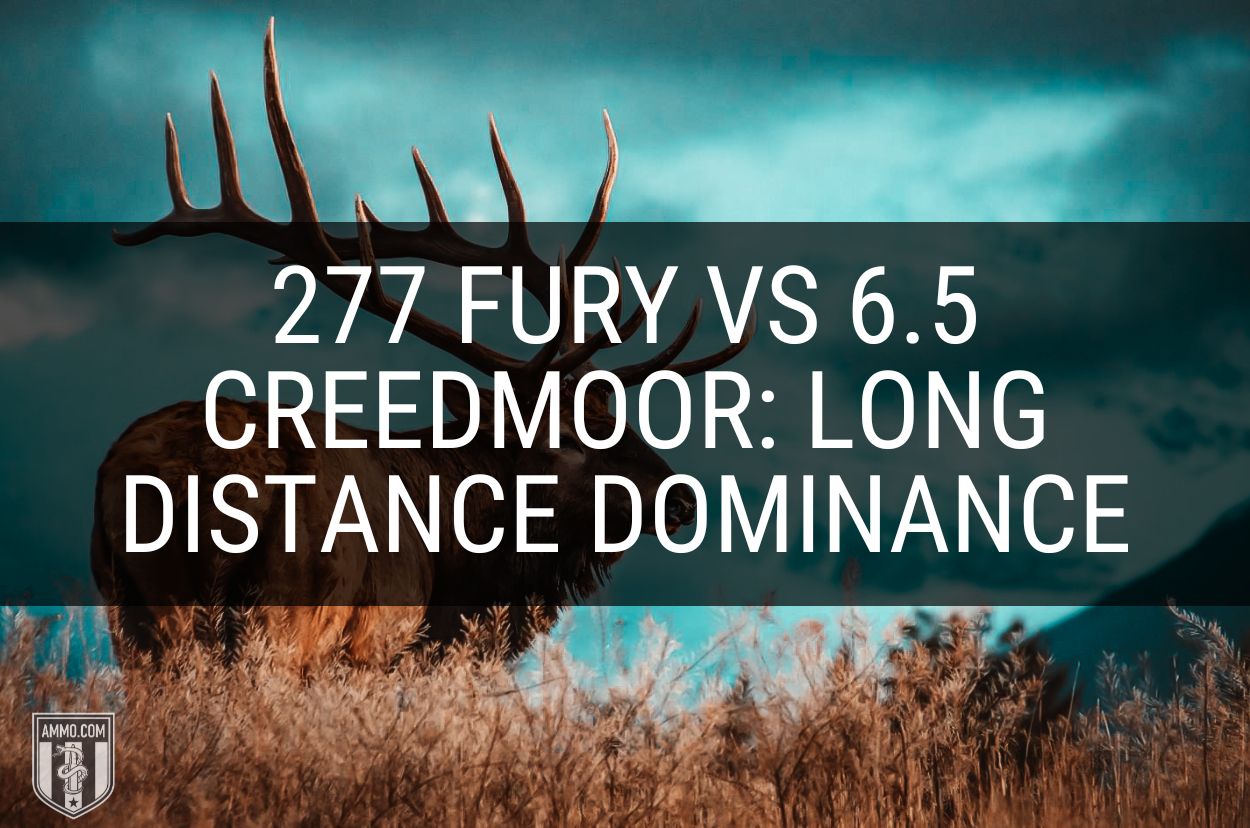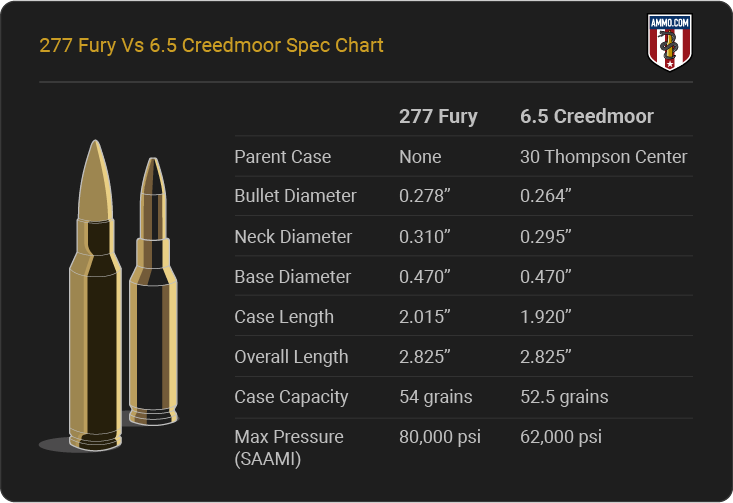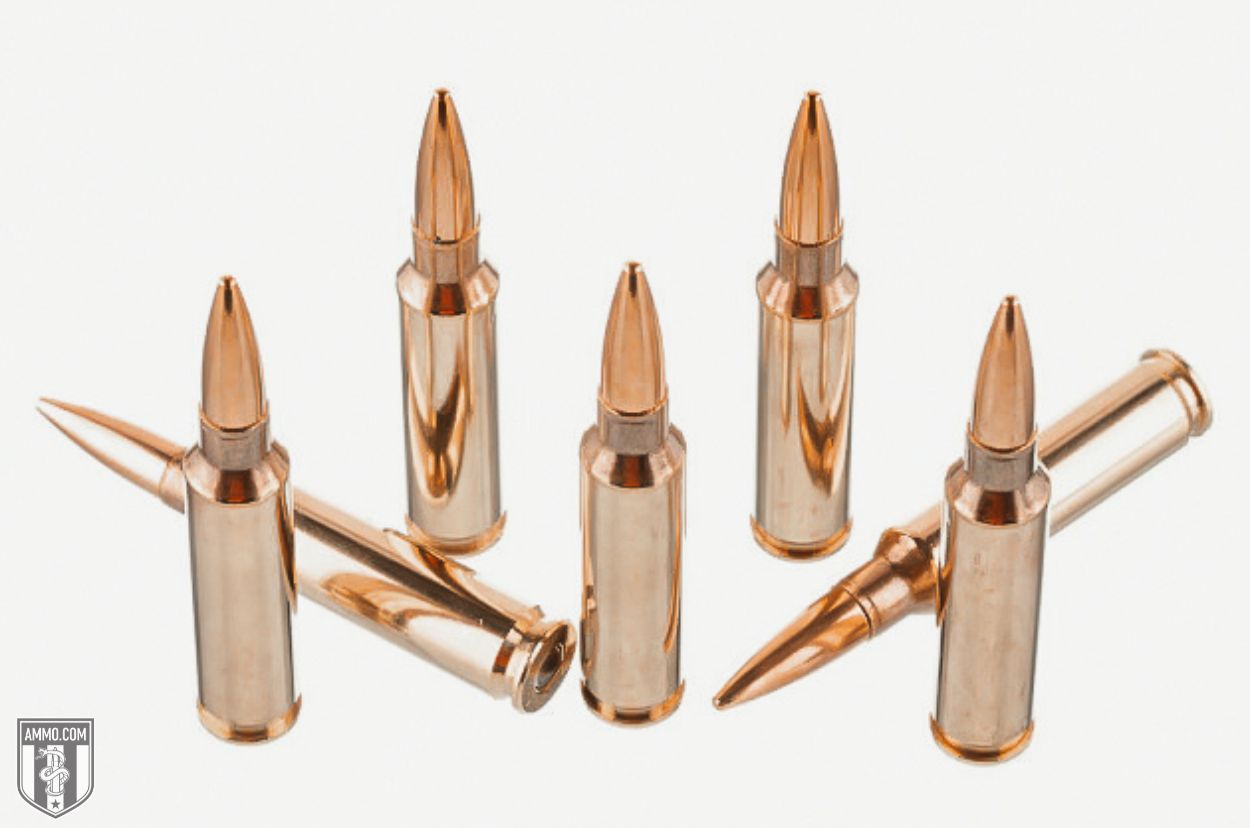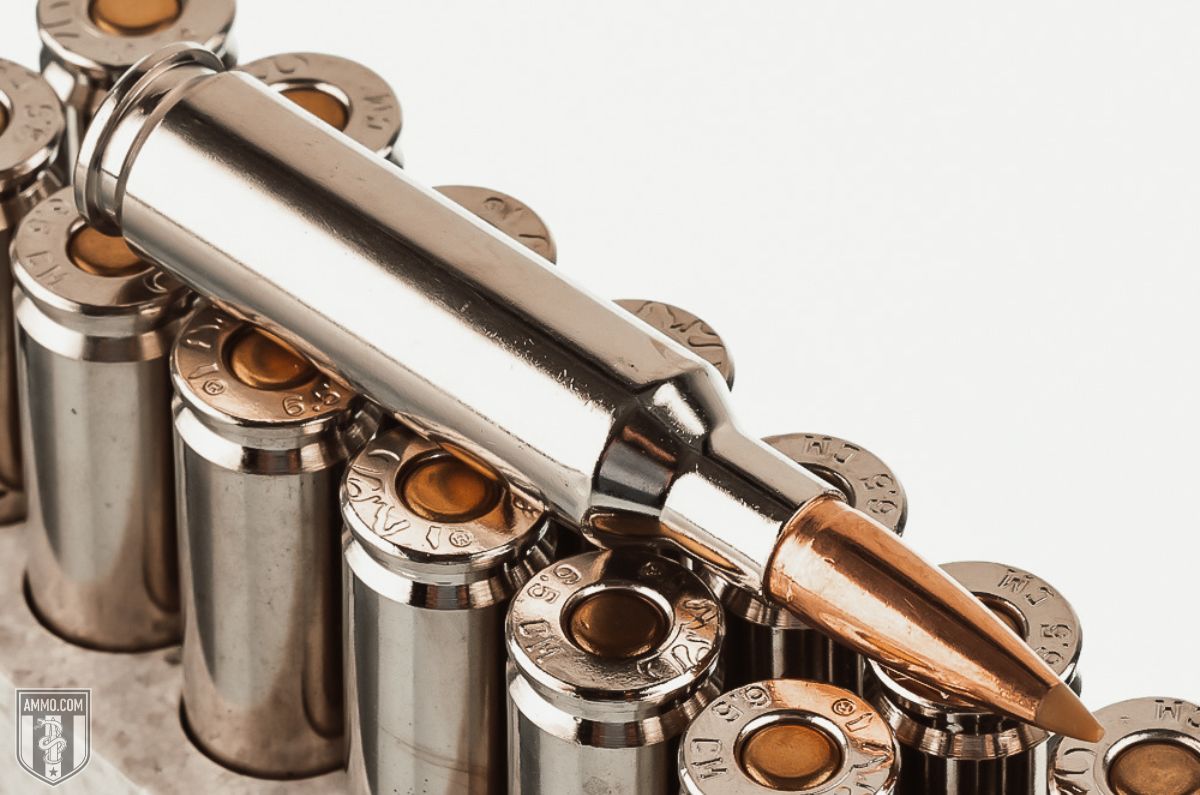277 Fury vs. 6.5 Creedmoor: Long Distance Dominance

When deciding between 277 Fury vs. 6.5 Creedmoor, which one is better?
It all depends on several factors, including what you plan to use the cartridge for, which is why I've forced these two rounds head to head in several scenarios to determine which is best.
However, I have a feeling one has a significant advantage over the other. Let's get started to see if it is accurate or just in my head.
.277 Fury vs 6.5 Creedmoor Caliber Comparison
Below, you'll find the .277 Fury and 6.5 Creedmoor compared across many factors and scenarios to help you decide which is best for your situation. At the end of the article, I'll tally up the winners of each category and reveal the overall winner.
But first, let's start with the cartridge specs for each to help you grasp the size difference.
Cartridge Specs
The 277 Fury claims it doesn't have a parent case; however, it's nearly identical to the 308 Winchester and 6.5 Creedmoor with the same length and diameter as the .308 Win. The 6.5 Creedmoor is based on the lesser-known 30 Thompson Center, but the cartridges are comparable overall.
In fact, I don't recommend shooting them side-by-side as they could easily be misidentified and create a catastrophe when loaded into the wrong rifle.
The most significant difference between these two calibers is the max pressure. As of this writing, the SIG Fury has the highest pressure of any cartridge approved by the Sporting Arms and Ammunition Manufacturers' Institute (SAAMI).

The higher pressure is intended to achieve body armor-piercing capabilities at 500 yards. Sig Sauer can safely produce this high-pressure, thanks to the 277 Fury hybrid case, which utilizes a brass body and stainless steel case head joined with an aluminum locking washer.
While it's still unproven, barrel life is a big concern for shooters. The higher pressure is expected to shorten the barrel's life drastically for competitive shooters.
Just by comparing the two cartridges based on size, the 277 SIG Fury is slightly larger, and bigger is always better, right?
I guess we're about to find out!
Recoil
Maybe I'm just a wimp because I believe recoil should be a significant consideration when buying a new firearm, especially for long-distance shooting.
Many new shooters are scared of feeling the thud of a rifle slam into their shoulders, which is why they are concerned with the amount of recoil. While more experienced shooters understand that less recoil tends to mean more accuracy, not necessarily that they're scared of the increased recoil.
Free recoil energy is entirely determined by muzzle velocity (feet per second, or fps), powder charge weight, bullet weight, and rifle weight.
The 277 Fury has a felt recoil of about 20 ft-lbs, which is very comparable to one of the all-time great long-range cartridges, the 308 Winchester.
The 6.5 Creedmoor edges out the 277 Fury with 17 ft-lbs of free recoil. However, it's not likely you'll notice much of a difference when firing these rifles.
The higher chamber pressure of the new cartridge creates a little more recoil and causes it to lose the first category to the 6.5 Creedmoor.
Trajectory
| Velocity | Energy (ft-lbs) | Trajectory (in.) | ||||||||||||||||||
|---|---|---|---|---|---|---|---|---|---|---|---|---|---|---|---|---|---|---|---|---|
| Bullet | Length (in) | G1 BC | 0yds | 100yds | 200yds | 300yds | 400yds | 500yds | 0yds | 100yds | 200yds | 300yds | 400yds | 500yds | 0yds | 100yds | 200yds | 300yds | 400yds | 500yds |
| 6.5mm 156gr SP | 24 | 0.348 | 2559 | 2313 | 2082 | 1864 | 1662 | 1480 | 2269 | 1854 | 1501 | 1204 | 957 | 758 | -1.5 | 2.5 | 0.0 | -10.6 | -31.2 | -64.5 |
| 277 Fury 150gr AccuBond | 24 | 0.500 | 3120 | 2925 | 2738 | 2559 | 2387 | 2221 | 3243 | 2849 | 2497 | 2181 | 1898 | 1644 | -1.5 | 1.3 | 0.0 | -5.9 | -17.2 | -34.6 |
Knowing the bullet's trajectory is essential in long-range shooting. I have yet to meet a shooter who prefers a trajectory that looks like the first half of the McDonald's golden arches over a flat line.
Because both cartridges were designed for long-distance shooting, it's fair to say they'll both have reasonably flat trajectories.
A 277 Fury 150gr polymer tipped Nosler bullet zeroed in at 100 yards drops 3.1" at 200 yards, 24.6" at 400 yards, and 43.7" at 500 yards.
A 6.5 Creedmoor 147gr polymer tipped Hornady ELD Match bullet zeroed in at 100 yards drops 3.8" at 200 yards, 29.5" at 400 yards, and 52.7" at 500 yards.
As the distances increase, it's evident that the higher chamber pressure of the 277 Sig Fury allows the bullet to have a flatter trajectory.
The 277 Fury ties it all up by winning this category.
Accuracy
Due to all the factors that go into it, determining the accuracy of a round is challenging. The bullet, gun, shooter, and conditions all factor in, so I'll do my best to make them as equal as possible for a fair comparison.
I also believe recoil and trajectory are significant factors, so I typically use them to determine the winner of the accuracy category in my other cartridge comparison articles.
However, since each round won one of those categories, and I don't believe in ties (one reason I find it challenging to watch soccer), let's dive into the details.
There is no denying the 6.5 Creedmoor is incredibly accurate. It's constantly winning long-distance shooting competitions and is more than capable of making a 1,000-yard shot. But the 277 Fury has a flatter trajectory and only a minimal amount more recoil.
I must go with the 277 Fury being more accurate, especially at longer distances, thanks to the flatter trajectory.
Ballistic Coefficient
Ballistic coefficient (BC) is a mathematical representation of how aerodynamic a bullet is and how effectively it resists wind deflection. A higher BC means the bullet is more streamlined (aerodynamic), better resists crosswinds, and is less susceptible to wind drift than lower BC bullets. Longer, heavier bullets generally have a higher BC.
Anything over .500 is considered very good, and both cartridges fire bullets capable of exceeding a .500 BC.
The 277 Fury 150gr polymer-tipped bullet has a BC of .500.
However, the 6.5 Creedmoor Hornady 147 gr ELD-M has a BC of 0.697.
The 6.5 Creedmoor has the better ballistic coefficient of the two rifle cartridges.
Stopping Power
Read any of the gun forums, and there's always going to be someone concerned with stopping power. What do they mean by "stopping power," exactly?
Well, they could be talking about the size of the hole the bullet leaves behind, how deep the bullet penetrates, or how much energy it transfers to the target. Or a combination of all three.
None of this matters if you are only a target shooter, so if that's you, go ahead and skip to the next section. But if you are a hunter like me, you should stick around.
The 277 Fury bullet has a slight advantage because it leaves behind a slightly larger hole, but I don't believe it to be a significant advantage. Both bullets are dwarfed by the 338 Lapua Magnum, which propels a 250 grain bullet to a muzzle velocity of nearly 3,000 fps.
Their long, slender design also helps both bullets penetrate; however, the 277 Fury was purposely designed to pierce body armor at 500 yards. I haven't seen any deer, elk, or coyotes wearing body armor lately.
Both rounds' cases can seat 150+ grain bullets, but the 277 Fury cartridge propels its bullet faster and transfers more energy to whichever target it hits.
The 277 Fury cartridge has more stopping power than the 6.5 Creedmoor, no matter how we look at it.
Hunting
Neither round was developed for hunting, but both can take medium game such as deer, pronghorn, coyotes, and hogs.
The 277 Fury can also ethically harvest elk, which gives it the advantage in this section.
Home Defense
I'm not a fan of using rifles as home defense weapons. Yes, the M4 carbine chambered in 5.56 NATO is used in urban combat environments, but protecting your home is different from a military operation.
Even with a suppressor to dampen the noise, you must still concern yourself with over-penetration when firing a rifle cartridge, regardless of whether you're wielding a short-action rifle, bolt-action rifle, or semi-auto AR-15.
That's why I still prefer shotguns for home defense over rifles or pistols. But if I were pressed to choose between either of these cartridges in a home defense situation, I would reach for the 6.5 Creedmoor over the 277 Fury. It has less recoil, and is slightly less likely to punch through multiple walls.
Ammo & Rifle Cost/Availability
Availability and cost of the gun are significant determining factors when I purchase a new rifle.
The availability of ammo also matters because what good is a gun if you don't have ammo to shoot? It's an overpriced paperweight, and a very poor club.
That's why the 6.5 Creedmoor easily takes this category. You can get 6.5 Creedmoor ammo, which is much cheaper than 277 Fury ammo. However, 6.5 Creedmoor rounds can be as pricey as 277 Fury rounds.
The Lake City Army Ammunition Plant (which Winchester manages at the time of writing) makes 277 Fury ammo for the military. But on the civilian side of things, only Sig Sauer makes Fury ammo that you and I can buy.
6.5 Creedmoor ammo is much more readily available because companies like Hornady, Remington, Winchester, and many other manufacturers make 6.5 Creedmoor ammo.
The same remains true when buying a new rifle. The Sig Cross, a bolt action precision rifle, is chambered in 6.5 Creedmoor and 277 Fury, but it's much easier to find in 6.5 Creedmoor.
Sig Sauer is the only company making 277 Fury rifles (at the time of writing), which increases the price. For example, the Sig Sauer MCX-SPEAR, the semi-auto civilian version of the U.S. Army's XM7 machine gun, costs $8,000.
On the other hand, you can find 6.5 Creedmoor rifles in all price ranges, from $500 to several thousand dollars.
The 6.5 Creedmoor takes another category because it's less expensive and readily available to civilians.
Reloading
To save some money, shooters often reload. It saves money in the long run and allows you to control every variable of the ammo manufacturing process, so you get higher-quality ammo.
There is a ton of information and reloading supplies for the 6.5 Creedmoor, but the same can't be said about the 277 Fury because it hasn't been around long enough.
It's also yet to be determined how the hybrid case of the 277 Fury will hold up to reloading compared to the traditional brass case of the 6.5 Creedmoor.
Keeping this section short and sweet, the 6.5 Creedmoor takes the final category.
.277 Fury vs. 6.5 Creedmoor Ballistics
Below, the team at Ammo.com has created a couple of ballistics tables for the shooters addicted to the numbers.
.277 Fury Ballistics
Note: This information comes from ammo manufacturers. Actual ballistics obtained with your firearm can vary considerably from the advertised ballistics. Also, ballistics can vary from lot to lot with the same brand and type load.
| Velocity | Energy (ft-lbs) | Trajectory (in.) | ||||||||||||||||||
|---|---|---|---|---|---|---|---|---|---|---|---|---|---|---|---|---|---|---|---|---|
| Bullet | Length (in) | G1 BC | 0yds | 100yds | 200yds | 300yds | 400yds | 500yds | 0yds | 100yds | 200yds | 300yds | 400yds | 500yds | 0yds | 100yds | 200yds | 300yds | 400yds | 500yds |
| 150gr AccuBond | 16 | 0.500 | 2830 | 2647 | 2472 | 2303 | 2140 | 1985 | 2668 | 2334 | 2035 | 1766 | 1526 | 1312 | -1.5 | 1.7 | 0.0 | -7.4 | -21.5 | -43.1 |
| 150gr AccuBond | 24 | 0.500 | 3120 | 2925 | 2738 | 2559 | 2387 | 2221 | 3243 | 2849 | 2497 | 2181 | 1898 | 1644 | -1.5 | 1.3 | 0.0 | -5.9 | -17.2 | -34.6 |
6.5 Creedmoor Ballistics
Note: This information comes from ammo manufacturers. Actual ballistics obtained with your firearm can vary considerably from the advertised ballistics. Also, ballistics can vary from lot to lot with the same brand and type load.
| Velocity | Energy (ft-lbs) | Trajectory (in.) | ||||||||||||||||||
|---|---|---|---|---|---|---|---|---|---|---|---|---|---|---|---|---|---|---|---|---|
| Bullet | Length (in) | G1 BC | 0yds | 100yds | 200yds | 300yds | 400yds | 500yds | 0yds | 100yds. | 200yds | 300yds | 400yds | 500yds | 0yds | 100yds. | 200yds | 300yds | 400yds | 500yds |
| 90gr TNT | 24 | 0.240 | 3000 | 2613 | 2257 | 1931 | 1636 | 1382 | 1799 | 1365 | 1019 | 745 | 535 | 382 | -1.5 | 1.5 | 0.0 | -8.7 | -26.8 | -58.1 |
| 100gr ELD-VT | 24 | 0.448 | 3200 | 2978 | 2768 | 2567 | 2375 | 2192 | 2274 | 1970 | 1702 | 1464 | 1253 | 1067 | -1.5 | 1.2 | 0.0 | -5.8 | -16.8 | -34.0 |
| 120gr CX | 24 | 0.428 | 2925 | 2707 | 2500 | 2303 | 2114 | 1934 | 2280 | 1954 | 1666 | 1413 | 1191 | 997 | -1.5 | 1.6 | 0.0 | -7.2 | 24.0 | -42.6 |
| 130gr TGK | 24 | 0.510 | 2950 | 2766 | 2589 | 2419 | 2256 | 2098 | 2512 | 2208 | 1935 | 1690 | 1469 | 1271 | -1.5 | 1.5 | 0.0 | -6.7 | -19.4 | -38.9 |
| 140gr FMJBT | 21.75 | 0.491 | 2658 | 2479 | 2307 | 2141 | 1983 | 1832 | 2197 | 1910 | 1654 | 1425 | 1222 | 1043 | -1.5 | 2.1 | 0.0 | -8.6 | -24.9 | -50.0 |
| 156gr SP | 24 | 0.348 | 2559 | 2313 | 2082 | 1864 | 1662 | 1480 | 2269 | 1854 | 1501 | 1204 | 957 | 758 | -1.5 | 2.5 | 0.0 | -10.6 | -31.2 | -64.5 |
.277 SIG Fury Development
The 277 Sig Fury is the new cartridge Sig Sauer created for the Next Generation Squad Weapon (NGSW) program. The exact details of the development of the 277 Fury are still classified, but we know the U.S. Army needed it to pierce current and future body armor at 500 yards.
The creation of the 277 Fury was first announced at the end of 2019. However, SAAMI committee members couldn't meet until 2021 to decide on approving the new cartridge due to COVID-19 travel restrictions. It was eventually approved and is currently being produced at Lake City Army Ammunition Plant.
As civilians, we're patiently waiting for more companies to add the 277 Fury to their ammo lineup because supplying the U.S. military with small arms, ammo, and rifles remains the primary focus.
6.5 Creedmoor Development
Dennis DeMille is credited with creating the 6.5 Creedmoor. DeMille began working on the cartridge after being approached by several long-distance shooters complaining about the 6mm XC, which was damaging their rifles.
DeMille set out to devise a solution. It debuted 2007 SHOT Show. The 6.5mm Creedmoor had many skeptics at first, but since then, it has become one of the best-selling centerfire rifle rounds on the market.
It's capable of ethically bringing down big game and shooting 1,000 yards at the range.
Parting Shots: 277 Fury Vs 6.5 Creedmoor
Now that you've finished reading this 277 Fury vs. 6.5 Creedmoor article, you might be wondering why the U.S. government spent so much money and time developing and buying a new cartridge ... all I can say is it's the government. Most things they do don't make any sense.
If you kept track, you'll have counted 5/9 wins for the 6.5 Creedmoor and 4/9 wins for the 277 Fury. While close, I think most shooters will prefer the 6.5 Creedmoor over the 277 Fury.
Don't forget to satisfy all your ammo needs at Ammo.com before you head to the range!
Ammo Comparisons
- .308 vs 5.56
- 6.5 Creedmoor vs .308
- .300 Blackout vs .308
- .300 Win Mag vs .308
- .243 vs .308
- .308 vs .30-06
- 7mm-08 vs .308
- .270 vs .308
- 7.62x39 vs .308
- .223 vs .308
- .338 Lapua vs .308
- .380 ACP vs 9mm
- .223 vs 5.56
- .300 Blackout vs 5.56
- 9mm vs 45 ACP
- 9mm vs 40 S&W
- .357 SIG vs 9mm
- 10mm vs 9mm
- 9mm vs 9mm Luger
- .243 vs .270
- .300 Win Mag vs .30-06
- .270 vs .30-06
- .40 vs .45
- 38 Special vs 357
- 9mm vs 40 vs 45
- 5.56 vs 7.62x39
- 338 Lapua vs .30-06
- .30-30 vs .30-06
- 300 PRC vs 338 Lapua
- .30-06 vs 7mm
- 300 Win Mag vs 338 Lapua
- 300 PRC vs 300 Win Mag
- 300 WSM vs 300 Win Mag
- 338 Win Mag vs 338 Lapua
- 12 Gauge vs 20 Gauge
- 10mm vs 357 Mag
- .30-30 vs 7.62x39
- 224 Valkyrie vs 22-250
- 17 HMR vs 22 Mag
- 7.62x39 vs .300 Blackout
- 45 ACP vs 45 Auto
- 45-70 vs 30-30
- 300 Blackout vs 223
- 357 Magnum vs 9mm
- 350 Legend vs 300 Blackout
- 224 Valkyrie vs 223
- 45 ACP vs 38 Super
- 6.5 Grendel vs .308
- 17 HMR vs 22 LR
- 10 Gauge vs 12 Gauge
- 22-250 vs 223
- 45 Colt vs 45 ACP
- 350 Legend vs 30-30
- 5.7x28 vs 223
- 5.7 vs 9mm
- 5.56 vs 5.7
- 22 vs 9mm
- Buckshot vs Birdshot
- 450 Bushmaster vs 308
- 450 Bushmaster vs 223
- Buckshot vs Slug
- 6.5 Grendel vs 5.56 vs 223
- 6mm ARC vs 6.5 Grendel
- 44 vs 45
- 458 SOCOM vs 5.56
- 357 vs 44
- 32 ACP vs 380
- 300 Win Mag vs 338 Win Mag vs 338 Lapua Mag
- 450 Bushmaster vs 458 SOCOM vs 50 Beowulf
- 6mm Creedmoor vs 6.5 Creedmoor
- TMJ vs FMJ
- 44 Special Vs 44 Magnum
- 45 90 vs 45 70
- 6.8 Western vs 6.8 SPC
- 50 Beowulf vs 50 BMG
- 26 Nosler vs 6.5 PRC
- 28 Gauge vs 410
- 6.8 SPC vs 5.56
- 6.8 SPC vs 6.5 Grendel
- 6.8 Western vs 7mm Rem Mag vs .28 Nosler
- 6.8 Western vs 6.5 Creedmoor
- 22 Hornet vs 223
- 6.8 Western vs 6.5 PRC
- .410 vs 12 Gauge
- .410 vs 20 Gauge
- 22 LR vs 22 Mag
- 6mm ARC vs 243
- 7mm-08 vs 270
- 243 vs 6.5 Creedmoor
- Nickel vs Brass Casing
- 204 Ruger vs 223
- 50 Beowulf vs 5.56
- 260 Remington vs 6.5 Creedmoor
- 6mm Remington vs 243
- 28 Nosler vs 300 PRC
- 50 Beowulf vs 50 AE
- 22 Nosler vs 22-250
- 450 Marlin vs 45-70
- 300 Win Mag vs 300 Norma
- 458 SOCOM vs 300 Blackout
- 38-55 vs 45-70
- 22 Hornet vs 22 LR
- 300 Norma vs 338 Lapua
- 338 Lapua vs 50 BMG
- 28 Nosler vs 300 Win Mag
- 28 Nosler vs 6.5 Creedmoor
- 204 vs 22-250
- 458 SOCOM vs 45 70
- 44 40 vs 45 70
- 6.8 SPC vs 6.5 Creedmoor
- 450 Bushmaster vs 30-06
- 7mm Rem Mag vs 300 Win Mag
- 30 Carbine vs 223
- 25-06 vs 30-06
- 26 Nosler vs 28 Nosler
- 16ga vs 12ga
- 30 06 vs 7.62 x54R
- 9mm Makarov vs 9mm Luger
- 350 Legend vs 223
- 30 Carbine vs 5.56
- 6.5x55 vs 6.5 Creedmoor
- 6.5 Creedmoor vs 270 vs 25-06
- M193 vs M855
- 450 Bushmaster vs 458 SOCOM
- 6.5 Grendel vs 6.5 Creedmoor
- 350 Legend vs 5.56
- .277 Fury vs 6.8 SPC
- 277 Fury vs 300 Win Mag
- 10mm vs .45 ACP
- 277 Fury vs 223
- 6.8 SPC vs 300 Blackout
- 6.5 PRC vs 6.5 Creedmoor
- 277 Fury vs 308
- 277 Fury vs 6.5 Creedmoor
- 350 Legend vs 450 Bushmaster
- 277 Fury Vs 5.56 NATO
- 10mm vs 40S&W
- 32 ACP vs 9mm
- 32 Special vs 9mm
- 8.6 Blackout vs 300 Blackout
- 30 Super Carry vs. 9mm
- 5.56 vs 9mm
- .50 Action Express vs 9mm
- 7.62x25 vs. 9mm
- 10mm vs 44 Magnum
- 300 Blackout vs 300 Win Mag
- 6.5 Grendel vs 300 Blackout
- 460 Rowland vs 10mm
- 300 RUM vs 300 PRC
- 300 Norma vs 300 PRC
- 45 GAP vs 45 ACP
- 7mm PRC vs 300 Win Mag
- 300 PRC vs 6.5 Creedmoor
- 300 PRC vs 308
- 357 SIG vs 357 Mag
- 7.62x39 vs 7.62x51
- 243 Win vs 223 Rem
- 30 Nosler vs 300 PRC
- 6.5 Creedmoor vs. 30-06 Springfield
- 450 S&W vs. 44 Magnum
- 6.5 Creedmoor vs. 300 Win Mag
- 454 Cassull vs. 45-70 Govt
- 454 Cassull vs. 44 Mag
- 7.62x54r vs. 308 Winchester
- 22 ARC vs. 223 Rem
- Subsonic vs. Supersonic Ammo




